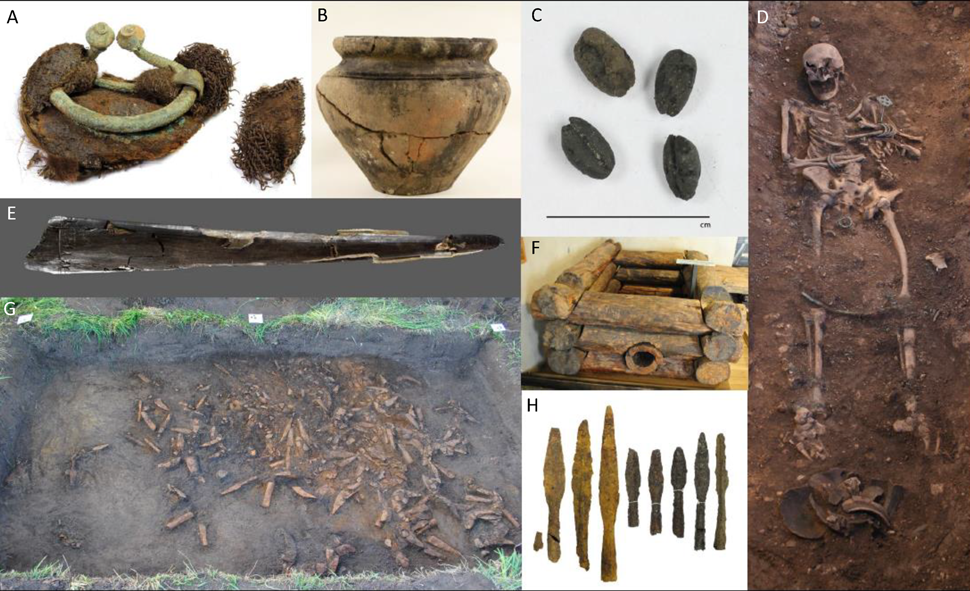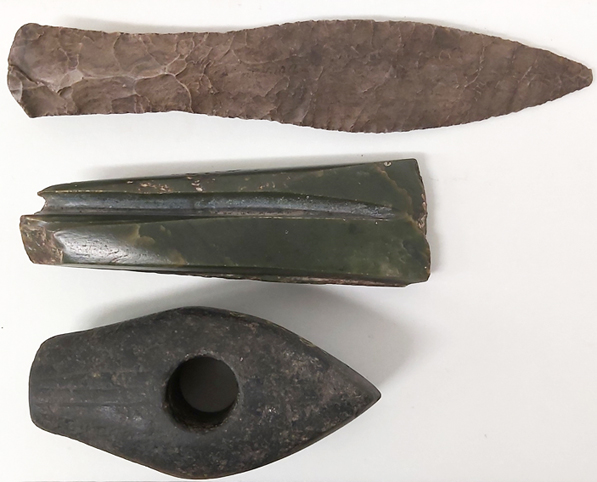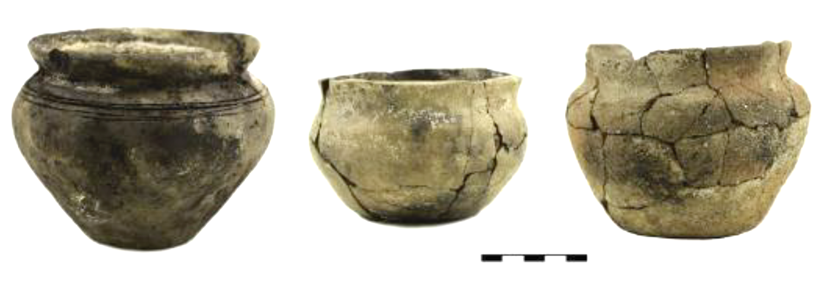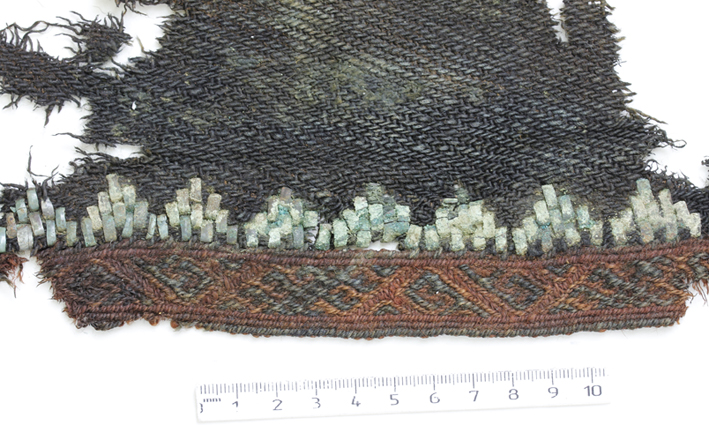
MOOC: Instrumental analysis of cultural heritage objects
Archaeological finds
Introduction
Archaeological objects (finds) are all the possible remains of all past human activity that come in different materials, forms, shapes and sizes (Fig. 1). As such they can be categorized in various ways:
- Artefacts (man-made objects) and ecofacts (natural objects like seeds, bones, coprolites);
- Organic (e.g. wood, charcoal, bone) and inorganic materials (e.g. lithics, ceramic vessels, metal objects);
Microscopic and/or molecular (e.g. starch granules from plant processing, lipid residues from animal fat cooked in pottery), and macroscopic (e.g. house remains, ancient field systems, cave paintings).

Many of those categories are crosslinked, often found and studied in relation to each other, sometimes even found as composite objects (e.g. iron sword found in a leather sheath decorated with bronze ornaments). However, considering find conditions (wet, arid, frozen, etc.), the character of the material, and the time passed, which may vary from several hundred years (Modern Period archaeology) to several thousands of millennia (early hominids), the preservation of different objects in archaeological contexts varies remarkably. It is obvious that stone objects are more durable to environment and time in comparison with e.g. wooden items or textiles.
The most common way to categorise archaeological objects is by major object types. The following text is mostly based on European archaeological material.
Lithics
Lithics is a large find group consisting of various mineral (stone) objects, and it is the best and longest preserved archaeological material surviving over the millions of years. Stones have been used throughout prehistory for building various structures, ramparts, houses, hearths, stone-graves, field systems, etc. Considering stone-artefacts, the vast majority of lithics material is from the Stone Age (Paleolithic, Mesolithic, Neolithic, i.e. old, middle and new Stone Age respectively) and contain very different tools from hand– and other axes, adzes, various cutting blades, micro inserts (small lithic flakes inserted into organic material handle), burins and scrapers. In addition to actual artefacts, a large number of archaeological finds include production remains of stone objects such as knapping debris and cores. Furthermore, sometimes even ornaments (beads, pendants) or figurines can be made of stone. Besides the Stone Age material, lithics objects are found in later periods – mainly as various grinding stones and stands, whetstones, strike-a-light-stones, etc.
The most widely spread material used in Europe for stone objects in Stone Age is flint (consist of over 95% SiO2, plus various other trace elements) found naturally in many places across the world. However, other siliceous rocks, like quartz and obsidian, but other materials such as porphyry and metatuf have been also used for making different tools [1]. Additionally, various stone materials unsuitable for lithic (cutting) tools due to their physical characteristics can be used for building and other purposes (lime-stone, sandstone). Very often locally available stone material has been used, but there are also several examples of long-distance trade of lithic objects covering thousands of kilometres [2].

Ceramic objects
The vast majority of ceramic items is formed by ceramic vessels i.e. pottery, usually found as pot sherds (Fig. 3). Pottery, which is by far the dominant find group in archaeology, was used for various food procurement practices, cooking and storage. Other and considerably rarer clay-made objects include clay figurines. Clay has been also widely used as a building material found in the forms of various daubs (from building remains, ovens), clay walls and floors, etc. In later periods also quite different objects such as Modern Period clay pipes can be found.

The earliest evidence of pottery is from around the 20,000 – 12,000 cal BC from East Asia. It has been proposed that the innovation of pottery production spread from there towards west over several millennia [3] and pottery is indeed closely connected to hunter-gatherer societies [4]. In different regions of Europe the arrival of pottery varies in time from 7th to 5th millennium cal BC and different cultural names have been associated with the evidence of first pottery (e.g. Linear Band Ceramics in western Europe, Ertebølle in Scandinavia, Nemunas and Narva ware in the eastern Baltic etc.).
Since the arrival of ceramics in the second half of the Stone Age there has been a continuous use and development of various vessel types up to nowadays. The forms and shapes vary in time and range from large pointed base vessels to small bowls, large storage vessels to drinking cups. Vessels have been formed from clay coils (mostly Stone Age) or larger lumps of clay. For many millennia the pots have been hand-made, whilst from in later periods, usually Iron Age, also wheel-thrown pots emerge [5]. Locally available clay sources have been mostly used as a raw material, to which various binding material and debris (organic plant remains, shells, stone debris, crog etc. depending on the location and time period) were added to improve various physical properties incl. the heat-persistence of the vessels. In later historical periods the amount of imported pottery including e.g. stoneware increases.
There are two main strands of studying archaeological pottery. First is the analysis of technological aspects including the study of clay material and additives for provenance and production techniques. The other approach is to study the function and use of the vessels via analysing microscopic plant and animal remains preserved in pottery-related food-crust – charred food remains on the surface of the vessel [6-8].
Metal objects
With the discovery and invention of various metallurgical techniques, a turn from the Stone Age (Neolithic as the final, neo = new Stone Age period) to the Metal Ages (including Copper, Bronze and Iron Ages with their numerous sub-periods) takes place brining along various metal objects. The major artefact groups made from different metals include weapons, tools and ornaments. The most widely spread materials are various copper alloys (Cu mixed with Sn, Pb, Zn etc.) and iron (from the Iron Age, ca 500 BC, onwards), but precious metals such as silver and gold also occur. Ornaments are mostly made of copper alloys and precious metals, whilst weapons and tools are usually made of iron, in earlier periods sometimes also copper alloys.
Archaeometallurgy is the common name for various analyses of metal objects. The major hindrance for the analysis of metal objects is the possibility to mix various metal sources and reuse metal objects i.e. using old artefacts as raw material and re-melting and -casting them into new ones [11]. The latter sets certain limitations to interpretations of the results, in particular regarding provenance studies. Additionally, metal corrosion resulting in damaged structures is the major problem for iron but also tin artefacts, whilst copper alloys, and gold and silver objects in particular are chemically more stable and less susceptible to environmental damages.
Leathers and textiles
Leather as the material has been widely used from the Stone Age onwards for clothing and footware, storage facilities (leather bottles) but also building material (coverage for huts) and toolmaking (attaching blades to handles). In later periods leather was also widely used for written records, e.g. as parchment. It can be presumed that the similar long-term use also applies to textiles, yet the direct evidence of early textile finds are scarce and often found as secondary marks (e.g. textile impressions on pottery). As with the leather, textiles can be used for numerous purposes, yet the most common is clothing and living conditions (decoration and warmth) as well as means for binding and attaching various objects (ropes and strings).
For leather items both wild and domesticated species were used and the selection of animal depended on the local availability (lack of domesticated species in earlier periods), purpose of use and objects made from it e.g. for parchment sheep/goat and cattle was usually preferred. Textiles consist of fibres made from either animal products (wool, hair from sheep, goat) or plant fibres (see more in the section Textiles and dyes). In the northern hemisphere the most common plant fibres used for textile production is linen and hemp, but nettle can be used as well. Fibres are spun together forming long yarns woven into long strands. Textiles but also leather, can be coloured using dyes and pigments. Leather can be treated by tanning in order to improve its various chemical and physical characteristics such as weather-persistence and handling (softening).
Leather and textiles are all organic materials – leather is made up from animal collagen. Wool and hair mostly consist of protein called keratin, whilst plant fibres are made from cellulose (see more in the section Textiles and dyes). As such they are subject to rapid (on archaeological time scale) degradation and decomposition. This is the reason why these finds are rare and very special under archaeological conditions, for which usually humid and anaerobic conditions like peat and cess pits are the best preservatives [12]. Sometimes also other material such as copper (namely copper corrosion) buried in contact with textiles or leathers, may help to preserve these materials (see Fig. 4). For this reason, bronze spirals used in textiles decorations or bronze ornaments attached to textiles can be particularly useful for textile studies.

Bone material
Archaeological bone material (osseous material) contains human as well as animal bones. Osseous material includes all the different parts of the skeleton including various bones and teeth. The vast majority of bone finds are ecofacts, but bone material has been used for making tools (awls, harpoons), weapons (spear), toys and other artefacts (buttons).
Bones can be found in a whole variety of contexts and functions. They are remains of food consumption, various production practices, but also funerary practices (cemeteries). Depending on the function and relevant cultural practices they can appear as both burnt (fired food remains in hearths, cremations in cemeteries) and unburnt (rubbish pits, inhumation cemeteries) material, worked or deformed (polished, with gnawing and cut-marks).
Bone is made up from both mineral and organic components i.e. hydroxyapatite (a calcium phosphate mineral, 60-70%) and a protein called collagen (ca 27%).
As partly organic material, the major concern with osseous material is its overall preservation, which depends strongly on the depositional environment (acidity, humidity, aridity etc.). E.g. in the eastern Baltic and Scandinavia the bone material is generally well preserved, although acidic and arid sandy grounds (e.g. in Finland) are often devastating for bone preservation [13]. The other issue is the preservation of collagen. Visually the bone can be well preserved but its collagen can be degraded over time and such a material cannot be used for further analysis (e.g. stable isotope analysis or AMS dating).
Organic and other residues
In addition to archaeological artefacts there are various amorphous residues attached to or found together with man-made objects or even ecofacts (dental calculus). These residues can be both organic or inorganic.
The major group of organic residues include archaeological food residues. These can be visible food remains, like food crusts, attached to the surface of the cooking or storage vessels, but also absorbed into the vessel’s (ceramic) matrix, or cooking environments (hearth stones, sediments) or textiles [14-17]. Additionally, there can be microscopic plant remains – carbohydrate rich starch grains, or silicate-based phytoliths or pollen grains preserved in the food-crusts or related vessels, human dental calculus, but also soaked into the cavities of stone artefacts like grinding stones or burins or cutting flakes [18-20]. In addition to food residues, there are various adhesives, lubricants, ointments, glues, medical mixtures etc. that can be found attached to various archaeological objects or within different containers [14]. Residues can be also analysed from ancient sediments or even coprolites [14,21].
The exact composition of residues varies considerably. In the case of organic residues, the major analyte class is lipids due to their better preservation and endurance to various depositional and environmental conditions. This applies to both food residues, but also adhesive, ointments, medicaments, but also sediments.
The major concerns for residue analysis, especially for organic matter, is the (often extensive or even complete) degradation resulting in alteration of initial molecular profile or morphological features [14]. This may happen due to initial use and function of residues (cooking resulting in heating-related degradation of initial fatty content, or starch grain deformation), but also time and environment related degradation has to be considered, e.g. triacylglycerols decomposing into less diagnostic fatty acids, oxidation and hydrolysis changes the molecular profile of the initial substance. Furthermore, later contamination from find context’s environment and later storage and handling (e.g. moving pollen or starch grains, addition of artificial components like glues from the collection handling, modern hand-creams, soil pollution, plastic packaging) may influence the molecular profile of various residues as well [15,22-24]. Therefore the interpretation of the analytical results must be always conducted carefully considering the whole molecular profile and ideally combining different analytical techniques, but also taking into consideration all these different chemical reactions and alterations taking place in time.
- Andrefsky, W. Jr. Lithics: Macroscopic Approaches to Analysis; Cambridge University Press, 2005.
- Connecting Networks: Characterising Contact by Measuring Lithic Exchange in the European Neolithic; Kerig, T., Shennan, S., Eds.; Archaeopress archaeology; Archaeopress: Oxford, 2015.
- Jordan, P.; Gibbs, K.; Hommel, P.; Piezonka, H.; Silva, F.; Steele, J. Modelling the Diffusion of Pottery Technologies across Afro-Eurasia: Emerging Insights and Future Research. Antiquity 2016, 90 (351), 590–603. https://doi.org/10.15184/aqy.2016.68.
- Ceramics before Farming : The Dispersal of Pottery among Prehistoric Eurasian Hunter-Gatherers / Peter Jordan, Marek Zvelebil, Editors.; Jordan, P., Zvelebil, M., Eds.; Publications of the Institute of Archaeology, University College London.; Left Coast Press: Walnut Creek, Calif., 2009.
- Orton, C.; Hughes, M.; Hughes, M. Pottery in Archaeology; Cambridge University Press, 2013.
- Saul, H.; Wilson, J.; Heron, C. P.; Glykou, A.; Hartz, S.; Craig, O. E. A Systematic Approach to the Recovery and Identification of Starches from Carbonised Deposits on Ceramic Vessels. Journal of Archaeological Science 2012, 39 (12), 3483–3492. https://doi.org/10.1016/j.jas.2012.05.033.
- Kubiak-Martens, L.; Brinkkemper, O.; Oudemans, T. F. M. What’s for Dinner? Processed Food in the Coastal Area of the Northern Netherlands in the Late Neolithic. Veget Hist Archaeobot 2015, 24 (1), 47–62. https://doi.org/10.1007/s00334-014-0485-8.
- García-Granero, J. J.; Urem-Kotsou, D.; Bogaard, A.; Kotsos, S. Cooking Plant Foods in the Northern Aegean: Microbotanical Evidence from Neolithic Stavroupoli (Thessaloniki, Greece). Quaternary International 2018, 496, 140–151. https://doi.org/10.1016/j.quaint.2017.04.007.
- Pernicka, E. Provenance Determination of Archaeological Metal Objects. In Archaeometallurgy in Global Perspective: Methods and Syntheses; Roberts, B. W., Thornton, C. P., Eds.; Springer New York: New York, NY, 2014; pp 239–268. https://doi.org/10.1007/978-1-4614-9017-3_11.
- Jambon, A. Bronze Age Iron: Meteoritic or Not? A Chemical Strategy. Journal of Archaeological Science 2017, 88, 47–53. https://doi.org/10.1016/j.jas.2017.09.008.
- Radivojević, M.; Roberts, B. W.; Pernicka, E.; Stos-Gale, Z.; Martinón-Torres, M.; Rehren, T.; Bray, P.; Brandherm, D.; Ling, J.; Mei, J.; Vandkilde, H.; Kristiansen, K.; Shennan, S. J.; Broodbank, C. The Provenance, Use, and Circulation of Metals in the European Bronze Age: The State of Debate. J Archaeol Res 2019, 27 (2), 131–185. https://doi.org/10.1007/s10814-018-9123-9.
- Kite, M.; Thomson, R. Conservation of Leather and Related Materials; Routledge, 2006.
- Kibblewhite, M.; Tóth, G.; Hermann, T. Predicting the Preservation of Cultural Artefacts and Buried Materials in Soil. Science of The Total Environment 2015, 529, 249–263. https://doi.org/10.1016/j.scitotenv.2015.04.036.
- Evershed, R. P. Organic Residue Analysis in Archaeology: The Archaeological Biomarker Revolution. Archaeometry 2008, 50 (6), 895–924.
- Roffet-Salque, M.; Dunne, J.; Altoft, D. T.; Casanova, E.; Cramp, L. J. E.; Smyth, J.; Whelton, H.; Evershed, R. P. From the inside out: Upscaling Organic Residue Analyses of Archaeological Ceramics. Journal of Archaeological Science: Reports 2017, 16, 627–640. https://doi.org/10.1016/j.jasrep.2016.04.005.
- Oras, E.; Lucquin, A.; Lõugas, L.; Tõrv, M.; Kriiska, A.; Craig, O. E. The Adoption of Pottery by North-East European Hunter-Gatherers: Evidence from Lipid Residue Analysis. Journal of Archaeological Science 2017, 78, 112–119. https://doi.org/10.1016/j.jas.2016.11.010.
- Oras, E.; Tõrv, M.; Jonuks, T.; Malve, M.; Radini, A.; Isaksson, S.; Gledhill, A.; Kekišev, O.; Vahur, S.; Leito, I. Social Food Here and Hereafter: Multiproxy Analysis of Gender-Specific Food Consumption in Conversion Period Inhumation Cemetery at Kukruse, NE-Estonia. Journal of Archaeological Science 2018, 97, 90–101. https://doi.org/10.1016/j.jas.2018.07.001.
- Buckley, S.; Usai, D.; Jakob, T.; Radini, A.; Hardy, K. Dental Calculus Reveals Unique Insights into Food Items, Cooking and Plant Processing in Prehistoric Central Sudan. PLOS ONE 2014, 9 (7), e100808. https://doi.org/10.1371/journal.pone.0100808.
- Hardy, K.; Radini, A.; Buckley, S.; Sarig, R.; Copeland, L.; Gopher, A.; Barkai, R. Dental Calculus Reveals Potential Respiratory Irritants and Ingestion of Essential Plant-Based Nutrients at Lower Palaeolithic Qesem Cave Israel. Quaternary International 2016, 398, 129–135. https://doi.org/10.1016/j.quaint.2015.04.033.
- Radini, A.; Nikita, E.; Buckley, S.; Copeland, L.; Hardy, K. Beyond Food: The Multiple Pathways for Inclusion of Materials into Ancient Dental Calculus. American Journal of Physical Anthropology 2017, 162 (S63), 71–83. https://doi.org/10.1002/ajpa.23147.
- Baeten, J.; Mees, F.; Marinova, E.; De Dapper, M.; De Vos, D.; Huyge, D.; Van Strydonck, M.; Vandenberghe, D.; Linseele, V. Late Pleistocene Coprolites from Qurta (Egypt) and the Potential of Interdisciplinary Research Involving Micromorphology, Plant Macrofossil and Biomarker Analyses. Review of Palaeobotany and Palynology 2018, 259, 93–111. https://doi.org/10.1016/j.revpalbo.2018.09.014.
- Heron, C.; Evershed, R. P.; Goad, L. J. Effects of Migration of Soil Lipids on Organic Residues Associated with Buried Potsherds. Journal of Archaeological Science 1991, 18 (6), 641–659. https://doi.org/10.1016/0305-4403(91)90027-M.
- Heron, C.; Evershed, R. P. The Analysis of Organic Residues and the Study of Pottery Use. Archaeological Method and Theory 1993, 5, 247–284.
- Steele, V. Organic Residues in Archaeology: The Highs and Lows of Recent Research. In Archaeological Chemistry VIII; ACS Symposium Series; American Chemical Society, Oxford University Press: Washington, D.C., 2013; Vol. 1147, pp 89–108.


